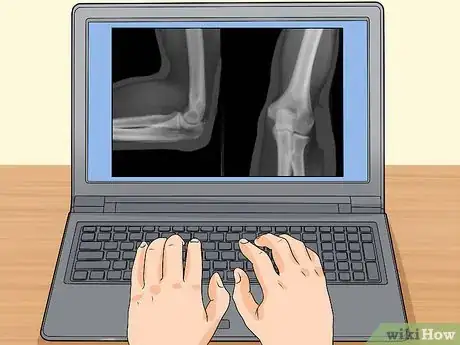This article was co-authored by Laura Marusinec, MD. Dr. Marusinec is a board certified Pediatrician at the Children's Hospital of Wisconsin, where she is on the Clinical Practice Council. She received her M.D. from the Medical College of Wisconsin School of Medicine in 1995 and completed her residency at the Medical College of Wisconsin in Pediatrics in 1998. She is a member of the American Medical Writers Association and the Society for Pediatric Urgent Care.
There are 11 references cited in this article, which can be found at the bottom of the page.
wikiHow marks an article as reader-approved once it receives enough positive feedback. In this case, 92% of readers who voted found the article helpful, earning it our reader-approved status.
This article has been viewed 201,161 times.
An X-ray (also called radiography) is a painless test used to see inside the body and differentiate between soft tissues and dense matter, like bones. An X-ray is commonly used for locating fractures and infections in the bones and detecting benign or cancerous tumors, arthritis, blocked blood vessels, or tooth decay. It can also be used for diagnosing digestive tract problems or swallowed foreign objects. In this article, we’ll tell you exactly what to do and expect for an X-ray exam, no matter which part of your body is getting tested. If you know what to expect and how to prep for the procedure, the process will go more smoothly (and you’ll be less anxious, too!).[1]
Things You Should Know
- After talking with your doctor, show up early to your X-ray appointment with an empty bladder, comfortable clothes, and no metal objects.
- Know that you may need to drink a contrast medium or hold your breath during the exam, but you won't feel anything while you're having your X-ray.
- Chest, bone, and GI tract X-ray exams all have different purposes and results, so get the details from your doctor beforehand.
Steps
Preparing for an X-Ray
-
1Consult your doctor before the procedure. It is essential that you talk to your doctor before getting an X-ray, especially if you are breastfeeding or if you are or think you might be pregnant. You will be exposed to small amounts of radiation that can be dangerous for the developing fetus.[2]
- Depending on the circumstance, another imaging test might be used to avoid radiation.
-
2Ask if you need to be fasting. Depending on the type of X-ray test you receive, your doctor may ask you to fast before the exam. This is usually only necessary for certain X-rays of your digestive tract.[3] Fasting normally requires you to not eat or drink for eight to 12 hours before your test.
- If you regularly take medication and are required to fast before an X-ray, take the medicine only with a small sip of water.
Advertisement -
3Wear comfortable clothes and shoes. Dress comfortably for an X-ray because you will most likely be removing your outfit prior to the exam and/or sitting and waiting for an extended period of time.[4]
- Wear loose clothing that you can easily remove, such as a button-up shirt and even a front-clasping bra for women.
- If you are receiving a chest X-ray, you will normally undress from the waist up. In this case, you will get a gown to wear during the exam.
-
4Remove all jewelry, glasses, and metal objects. It is best to leave your jewelry at home as you may need to remove it for the exam. If you wear glasses, you may need to remove these as well.
-
5Arrive early to your appointment. Just in case you need to fill out additional paperwork, it is better to arrive early to your appointment. Also, you may be asked to take a contrast medium before the test.
- Also, remember to bring a signed form from your doctor (if you have one) when you visit the X-ray technician. This form tells the technician what areas of the body are being examined and what X-ray test should be done.
- Don't forget your insurance card.
-
6Empty your bladder prior to the procedure if you are having an abdominal X-ray. You cannot move or leave the exam room once the procedure has begun. Try relieving yourself before the exam and do not drink excessively on the morning of the procedure.
-
7Be prepared to drink a contrast medium (if applicable). Some X-ray tests require you to drink a contrast medium that helps outline a specific area of your body on the X-ray image. Depending on the type of X-ray test that will be administered, you may be asked to:[5]
- Drink a solution of barium or iodine.
- Swallow a pill.
- Receive an injection
-
8Be aware that you may have to hold your breath for a few seconds during the X-ray. Holding your breath helps the heart and lungs show up more clearly on the X-ray image. Depending on the type of X-ray, you may also need to hold still and/or move to different positions.[6]
- The X-ray technician will position your body between the machine and a plate that creates the digital image.
- Sometimes sandbags or pillows might be used to hold you in a certain position.
- You may be asked to move in different positions so front and side views can be captured.
-
9Expect not to feel anything during the X-ray exam. An X-ray is a painless procedure during which X-ray beams pass through your body and record an image. This procedure usually takes minutes for bone X-rays but can go longer if a contrast medium is used.[7]
Different Types of X-Rays
-
1Know what to expect during a chest X-ray. A chest X-ray is one of the most common X-ray procedures and is used to produce images of the heart, lungs, airways, blood vessels, and the bones of the spine and chest. It's normally used for diagnosing problems such as:[8]
- Shortness of breath, bad or persistent cough, and chest pain or injury.
- It can also be used for diagnosing or monitoring conditions such as pneumonia, heart failure, emphysema, lung cancer, and fluid or air around the lungs.
- If your doctor recommends that you should get a chest X-ray, no special preparation is required – just follow the steps mentioned above.
- A chest X-ray takes about 15 minutes and often requires two views of the chest to be taken.
-
2Learn what to expect during a bone X-ray. A bone X-ray is used to take images of the bones in your body to detect fractures, joint dislocations, injury, infection, and abnormal bone growths or changes.[9] If you have pain from an injury, talk to your doctor about taking medication for pain before the X-ray, as the technologist may need to move your bones and joints for the procedure.
- A bone X-ray can also be used to screen for bone cancer or other tumors, or to locate foreign objects in soft tissues around and/or in the bones.
- If your doctor orders a bone X-ray, no special preparation is required – just follow the steps mentioned above.
- Bone X-rays typically take about five to ten minutes to complete. When getting a bone X-ray, an image of the unaffected limb may be taken for comparison.
-
3Know if you need an upper gastrointestinal (GI) tract X-ray. An upper GI tract X-ray can be used to diagnose injuries or problems within the esophagus, stomach and small intestines.[10] In addition, your doctor may order a KUB, which is a plain X-ray of your abdomen.
- This type of procedure uses a special X-ray called fluoroscopy, which helps to visualize the internal organs in motion.[11]
- Be prepared to take a barium contrast solution prior to the exam.
- In some cases, you may also need to take baking soda crystals to further improve the X-ray images.
- An upper GI tract X-ray helps diagnose symptoms such as difficulty swallowing, chest and abdominal pain, acid reflux, unexplained vomiting, severe indigestion, and blood in the stool.[12]
- It can be used to detect conditions such as ulcers, tumors, hernias, intestinal blockage, and inflammation.[13]
- If your doctor orders an upper GI tract X-ray, you typically need to fast for eight to 12 hours prior to the test.
- Also, remember to empty your bladder before the exam if possible.
- This type of X-ray test takes about 20 minutes to complete. This examination could also make you feel bloated and you might experience constipation or your stool might turn gray or white from the contrast medium for 48 to 72 hours after the procedure.[14]
-
4Know what to expect during a lower GI tract X-ray. A lower GI tract X-ray examines the colon, the appendix and possibly a small portion of the small intestine. This type of X-ray also uses fluoroscopy and a barium contrast.
- A lower GI tract X-ray is used to diagnose symptoms such as chronic diarrhea, blood in stool, constipation, unexplained weight loss, bleeding and abdominal pain.
- Your doctor can use a lower GI tract X-ray to detect benign tumors, cancer, inflammatory bowel disease, diverticulitis, or blockage of the large intestine.
- If your doctor orders a lower GI tract X-ray, you are required to fast after midnight and to only drink clear liquids such as juice, tea, black coffee, cola, or broth.
- You may also need to take a laxative to clean out your colon the night before the exam.
- Also, remember to empty your bladder before the exam if possible.
- A lower GI tract X-ray takes about 30-60 minutes to complete. You may feel abdominal pressure or minor cramping. After the exam, you will be given a laxative to wash the barium out of your system.[15]
-
5Learn the details of a joint X-ray. An arthrography is a special X-ray used to diagnose conditions that affect your joints. There are two types of arthrography imaging: indirect and direct.[16]
- Indirect arthrography requires contrast material to be injected into the blood stream.
- Direct arthrography requires contrast material to be directly injected into the joint.
- The procedure can be done to look for abnormalities, pain or discomfort in the different joints in your body.
- Arthrography may also be done using computed tomography (CT) scanning or magnetic resonance imaging (MRI).
- If your doctor orders an arthrography, no special preparation is required – just follow the steps mentioned in the first section.
- In some cases you may need to fast, but only if you are getting a sedative.
- An arthrography usually takes about 30 minutes. You will experience a pinprick and may feel burning if an anesthetic is used to numb the joint area.
- You may also feel pressure or pain when the needle is injected into the joint.[17]
Warnings
- Warn your doctor or X-ray technician if you are or may be pregnant.⧼thumbs_response⧽
- Routine X-rays are considered fairly safe but most doctors recommend waiting at least 6 months and sometimes up to a year to undergo the same routine X-ray due to radiation exposure, unless they are needed sooner (as often you may need a repeat CXR 1-2 weeks after pneumonia, or repeat films in a few weeks for fractures). If you have concerns about the risk of radiation exposure, make sure to address them with your doctor before the test.⧼thumbs_response⧽
References
- ↑ http://www.mayoclinic.org/tests-procedures/x-ray/basics/definition/prc-20009519)
- ↑ http://www.mayoclinic.org/healthy-lifestyle/pregnancy-week-by-week/expert-answers/x-ray-during-pregnancy/faq-20058264
- ↑ https://www.radiologyinfo.org/en/info.cfm?pg=uppergi
- ↑ https://www.nhs.uk/conditions/x-ray/
- ↑ http://www.mayoclinic.org/tests-procedures/x-ray/basics/how-you-prepare/prc-20009519
- ↑ http://www.mayoclinic.org/tests-procedures/x-ray/basics/what-you-can-expect/prc-20009519
- ↑ http://www.mayoclinic.org/tests-procedures/x-ray/basics/what-you-can-expect/prc-20009519
- ↑ http://www.radiologyinfo.org/en/info.cfm?pg=chestrad
- ↑ http://www.radiologyinfo.org/en/info.cfm?pg=bonerad
- ↑ http://www.radiologyinfo.org/en/info.cfm?pg=uppergi
- ↑ http://www.radiologyinfo.org/en/info.cfm?pg=uppergi
- ↑ http://www.radiologyinfo.org/en/info.cfm?pg=uppergi
- ↑ http://www.radiologyinfo.org/en/info.cfm?pg=uppergi
- ↑ http://www.radiologyinfo.org/en/info.cfm?pg=uppergi
- ↑ http://www.radiologyinfo.org/en/info.cfm?pg=lowergi
- ↑ http://www.radiologyinfo.org/en/info.cfm?pg=arthrog
- ↑ http://www.radiologyinfo.org/en/info.cfm?pg=arthrog
About This Article
To prepare for an X-ray, start by talking to your doctor about any special requirements, like fasting for 8 to 12 hours before the test. On the day of your X-ray, wear comfortable clothes and shoes in case you need to remove your clothes to put on a gown. Additionally, be prepared to remove all jewelry, glasses, and metal objects. Make sure to arrive early to your appointment to fill out paperwork, provide insurance documents, and provide the form from your doctor ordering the X-ray. For more information from our Medical co-author, including how to hold your breath during an X-ray, keep reading!








































































Medical Disclaimer
The content of this article is not intended to be a substitute for professional medical advice, examination, diagnosis, or treatment. You should always contact your doctor or other qualified healthcare professional before starting, changing, or stopping any kind of health treatment.
Read More...